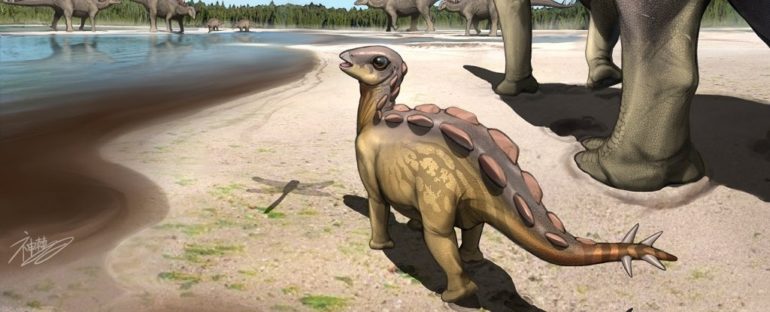In a complete redefinition of the concept of ‘cute’, an international team of paleontologists has identified the tiniest known stegosaur footprint.
Preserved in the stone in the Xinjiang Province of China for 100 million years, the print measures just 5.7 centimeters (2.24 inches) long, and was probably made by a baby stegosaur (ichnogenus Deltapodus) around the size of a cat, the research team said.
Fascinatingly, although we don’t know the wee little animal’s exact species, the print has allowed scientists to infer that baby stegosaurs may have walked differently from the adults.
“This footprint was made by a herbivorous, armoured dinosaur known broadly as a stegosaur – the family of dinosaurs that includes the famed stegosaurus,” said paleontologist Anthony Romilio of the University of Queensland in Australia.
“Like the stegosaurus, this little dinosaur probably had spikes on its tail and bony plates along its back as an adult. With a footprint of less than six centimeters, this is the smallest stegosaur footprint known in the world.”

We know that stegosaurs lived in the region. Dozens of tracks measuring up to 30 centimeters long have been found, as well as skeletal remains. Elsewhere in the world, stegosaur tracks rarely exceed 50 centimeters.
The footprints of very young stegosaurs and other armored dinosaurs are incredibly rare compared to other species, and it’s not entirely clear why.
It’s possible that, living in a herd, a lot of their prints were walked over by larger, heavier adults, but that doesn’t quite explain how other herd dinosaurs’ baby prints survived. Other explanations include rapid growth – the animals may not have been small for long enough to leave many tracks; or that the nursery habitats were generally not conducive to the preservation of footprints.
Whatever the reason for the scarcity, somehow this one single track survived. The baby’s three-toed foot pressed into the mud; time turned the mud to mudstone, creating a mold that filled with debris that in time turned to sandstone, creating a cast of the tiny step that survived when the mudstone weathered away.
Although not a lot of detail was preserved, the shape of the print was intriguing – it wasn’t elongated like the tracks of older stegosaurs, the researchers said.

“Stegosaurs typically walked with their heels on the ground, much like humans do, but on all fours which creates long footprints,” said Romilio.
“The tiny track shows that this dinosaur had been moving with its heel lifted off the ground, much like a bird or cat does today. We’ve only previously seen shortened tracks like this when dinosaurs walked on two legs.”
This tantalizing discovery suggests that baby stegosaurs could have moved more lightly and nimbly than the adults, walking on their toes and transitioning to heel-walking as they grow. However, with only a single footprint, it’s impossible to tell.
The specific individual stegosaur that made it could have had a strange way of walking; or perhaps it put its foot down oddly, just for that one step.
“A complete set of tracks of these tiny footprints would provide us with the answer to this question,” said paleontologist Lida Xing from the China University of Geosciences, who found the print, “but unfortunately we only have a single footprint.”
The region in which the print was found has yielded nine different dinosaur track sites; and the specific assemblage that included the baby print also had 16 other prints from older stegosaurs. Now that one baby print has been found, the team intends to search the formation for clues that can help us answer these fascinating questions.
The research has been published in Palaios.



